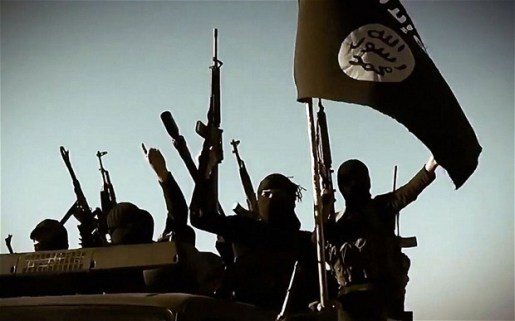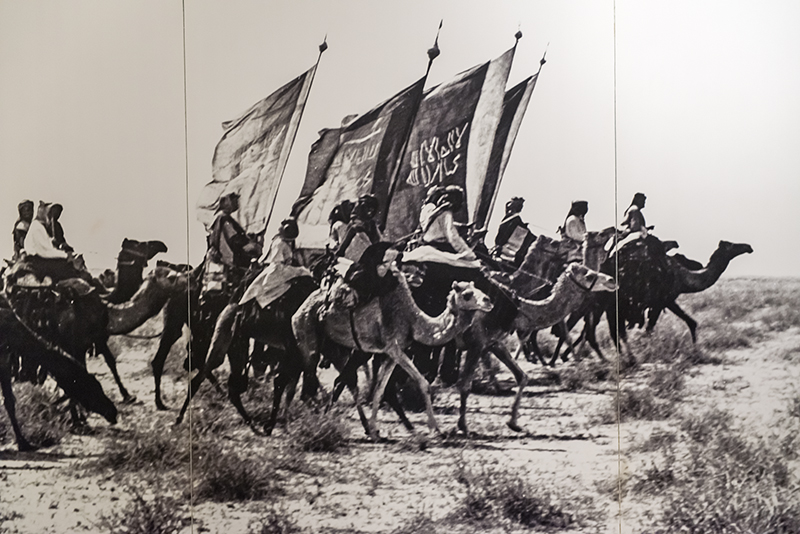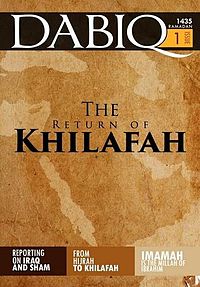
It is evident that the violent ideology - the best examples being the army of the Ikhwan, Juhayman and ISIS - didn't just fall from the sky all of a sudden. It came out of the books and curricula of the Wahhabi Salafist school indoctrinated via mosques and Sharia institutes.
THERE ARE MANY factors behind the emergence of the phenomenon of Islamic violence, including political, economic, social and psychological ones, and the most important of these is the “intellectual” factor resulting from the interpretation of texts of the Qur’ān and the hadith, in addition to many concepts and fatwas contained in works of fiqh and the Islamic tradition.
Since the ideas embraced by persons belonging to these violent currents are the result of these interpretations of the Qur’ān, the hadith and works of fiqh, it is no use – when challenged by those who say that violence is an integral dimension of Islam – contenting oneself with denying their claim or saying that Islam calls for tolerance, peace and love.
A proper response to those allegations would require us Muslims to be courageous with ourselves and take a wide-ranging, diligently look at the entire religious tradition, employing modern tools and methodologies of research. This is because the closing of the doors of ijtihād (‘independent legal reasoning’), which began in the ninth century AD, came to its completion in the twelfth century and thereby put the signature to Islamic civilization’s significant decline.
The decline set in once the Salafi school and its standpoint signed an alliance with the Abbasid Caliph al-Mutawakkil and the jurist Ahmad ibn Hanbal. Its control was then strengthened in the twelfth century by its second wave led by the jurist Taqī al-Dīn Ibn Taymiyyah, and finally emerged prominent in the alliance contracted in the Arabian Peninsula between the qādī from Dirʽiyya Muhammad ibn ‘Abd al-Wahhāb and Muhammad ibn Saʽūd in the middle of the eighteenth century.
Salafism is a ‘textual’ ideology in that it holds that the sacred texts are untouchable and are to be understood to the letter or the phrase, and is also ideologically ‘exclusivist’ since it strongly repudiates any discussion of its principles and is intolerant of any opposing views.
We have to take a wide-ranging, diligent look at the entire religious tradition
It is fixated on the past, in that it considers that the perfect pattern for thinking has already been applied in an earlier time, the time of the Salaf (‘ancestors’), and that what comes after must merely work to restoring this pattern and not break it. As a consequence, it seeks the future in the past, so that history for them does not represent a horizon of progress and evolution, but rather a journey towards decline and regression.
This way of presenting Salafism, as far as the present writer is concerned, is founded upon a superficial view held by many observers of the phenomenon of Islamist violence that there is no link between the Salafi school of Islamic thought, particularly is ‘Wahhabist’ version, and movements of violence prevalent today, and in particular the organisation of the Islamic State ‘ISIS’.
It is true that the wave of recent violent takfiri groups began in Egypt in the late 1960s under the direct influence of Sayyid Qutb’s ideas, which in turn were a development on from the ideas of Abū al-ʽAlā’ al-Mawdūdī, but it is also true that the latter was greatly influenced by the preaching of Muhammad ibn ‘Abd al-Wahhāb.
No serious researcher can contemplate the course and method of thinking, or the sources upon which the Wahhābī school is founded, without finding therein a close link between these and the exclusivist behavior, the violence and the takfīr that characterizes the violent movements.
When some opine that the general course of Salafism is one that rejects takfīr and is against the use of violence against non-Muslims, they are simply closing one eye to the truth, given that the sources from which the Wahhabīs and Takfīrīs draw their ideas are shared in common, and given that they also agree on how the Texts are to be read (that is, with a literal understanding). The difference between them therefore becomes one of degree and not of kind.
Anyone taking a look at the intellectual background of those mustering under the banner of violent movements, and the shaykhs who stand behind them, will find that they are powered by the fatwas of Ibn Taymiyyah and the writings of his disciple Ibn al-Qayyim, in addition to the teachings of Muhammad ibn ‘Abd al-Wahhāb, and that many of them have studied at the Islamic University or the University of Imam Muhammad bin Saud in Medina or other schools and colleges where Sharīʻa law is taught from the standpoint of the Salafists.
As for experience on the ground, we have the troops of King Abdul Aziz ibn Saud, known as the Ikhwān, who were the people most faithful to the teachings of Muhammad ibn ‘Abd al-Wahhāb and how through them the late king managed to extend his power over Nejd, the Hijaz and found the present-day kingdom.
The Ikhwān were not much different from present-day ISIS, for they expressed great hatred for non-Muslims, all of whom they customarily named ‘infidels’, and could not tolerate their presence in the Arabian Peninsula (we saw an echo of this sentiment of theirs repeated in the conversations of Osama bin Laden).
He grew up among the Ikhwān and was raised on the doctrine of al-walā’ wal-barā’ (‘loyalty and disavowal’) which divides the world into two camps: disbelief and belief, the same ideas that the Salafis of various stripes are brought up with today, and by which young people who go off to join ISIS are energized.
There is a close link between their exclusivist behavior and the violence
The Ikhwān were soldiers loyal to their idea of ‘purifying’, they were bloodthirsty, ready to die at any moment, and hostile to all manifestations of modern civic life such as the telephone and the car radio, on the grounds that these were innovations that may not be adopted.
They also do not recognize any thought or conception of Islam that contradicts ‘Wahhabism,’ least of all Sufism and Sufis, their goal being to force all Arab lands to re-enter ‘Islam’, despite the fact that their peoples are monotheistic Muslims. In fact, one of their points of disagreement with King Abdul Aziz was his refusal to press on with the war to subject Syria, Iraq and Jordan to his power and force their populations to submit to the dominion of the Wahhabi creed.
On the other hand, Juhaymān al-ʽUtaybī, who took over the Grand Mosque at Mecca at the dawn prayers on the first day of the 15th century AH had studied Sharīʻa in Mecca and the Islamic University of Medina as well, where the influence of Sheikh ʽAbd al-Azīz bon Bāz was dominating. There Juhaymān met with Muhammad bin Abdullah al-Qahtānī who was a preacher of Mahdism and one of the direct disciples of Bin Bāz.
Al-ʽUtaybī and al-Qahtānī, who shed the blood of Muslims worshipping in the sanctuary, were two distinguished students of Salafist Wahhabi thought and its greatest shaykh at the period: Sheikh ʽAbd al-Azīz bin Bāz. Al-ʽUtaybī and some of his colleagues went to Bin Bāz and told him that they wanted to establish a daʽwā group founded upon “the method of the Salaf, the war against heretical innovation and upon the Qur’ān and the Sunna, and the rule of the Qur’ān and the Sunna”. Bin Bāz them what the name of their group was, to which they replied: “The Salaf Group”. He replied: “Since you are calling for accounting (al-hisba) unto God, call it ‘al-Jamāʽa al-Salafiyya al-Muhtasiba and that became its name.
Al-ʽUtaybī has and his fellows were raised on a literal approach that eliminates the intellect, believes in the literal interpretation of the Texts, and turns the hadith into a source of law equivalent of the Qur’ān. They therefore believed in the appearance of the ‘Awaited Mahdī’ frequently mentioned in the hadīth associated with the infallible Prophet.
Al-ʽUtaybī, al-Qahtānī and their colleagues believed that the Mahdi should have allegiance pledged to him at the place between the Rukn and the Maqām[1], and that he would remain at the sanctuary. A host from Tabuk would come but will succumb to a landslide, following which this man would exit the sanctuary and proceed to Medina to fight the Antichrist. Then he would leave Medina for Palestine to fight the Jews there and slay them. Thereupon ʽIsā son of Mary would come and smash the Cross and slaughter the pig, and they would proceed on to Syria and pray at the Umayyad Mosque. After this there would take place the Great Resurrection.
All Wahhabis believe in these tales that pepper their books and education syllabuses. If they differ with al-ʽUtaybī and his fellows in anything, it is in the fact that their descriptions of the Mahdī did not apply to al-Qahtānī. But the difference is a mere secondary issue, since al-Qahtānī and his group saw the descriptions as applying to him as far as they could see it. This means that for as long as these tales persist, someone can turn up at any time and attempt to adapt them to his purposes.

Suggested Reading
The same thing applies to the ‘prophecy’ recorded in the Sahīh Muslim concerning the Great Slaughter, a prophecy most frequently exploited by ISIS to entice thousands of Muslim youth to join their ranks, so that they can plunge into the ‘End of Times’ battle with the infidel.
In his Sahīh Muslim narrates a hadith of Abu Hurayra whereby that the Prophet said:
The Hour will not begin until the Rūm (‘Byzantines’, i.e. Christians) come to a place called al-Aʽmāq or Dābiq and the Mahdī, with an army consisting of the best soldiers of the people of the earth at that time, will then issue forth from Madīna and when they form ranks the Rūm will say: “Do not stand between us and those (Muslims) who took prisoners from amongst us. Let us fight with them”; and the Muslims will say: “Nay, by Allah, we would never get aside from you and from our brethren that you may fight them.” Then a third of the army will run away, whom Allah will never forgive, another third made up of excellent martyrs in Allah’s eye will be slain and a third part, those who would never be put to trial, will win and conquer Constantinople. But as they busy themselves in dividing up the spoils of war with their sword hung on the olive trees, Satan will cry: “The Antichrist has taken your place among your family!” They will then come forth, but it will be of no avail. When they come to Syria he will come upon them while they are still preparing themselves for battle and forming their ranks. At which point it will be the time of prayer and ʽĪsā son of Mary will descend and lead them in prayer. When the enemy of Allah sees him, they will vanish just as salt dissolves in water. Even if ʽĪsā let them be they would still completely dissolve, for God will slay them by His own hand and show them their blood on his lance.
‘Dābiq’ is the name of a town in Syria, while al-Aʽmāq is a district of Antakya in Turkey. ISIS has taken the name Dābiq as the title for their official magazine, the mouthpiece for the organisation, and it continues to urge those rallying to their standard to plunge into the ‘End of Times’ battle prophesied by this hadith of Muslim. This battle is to end with the appearance of the Antichrist, the descent of the Messiah, and the defeat, once and for all, of the Infidel.
ISIS also bases its support on another hadith that indicates that the battle will be ‘huge’ and involve hundreds of thousands of soldiers. The Rūm will organise themselves under 80 standards, each numbering 12,000 fighters, making the total number of the host facing the Muslims 960,000 men.
The violent ideology came out of the books of the Wahhabi Salafist school
Propagators of Salafist thought are not able to condemn the ISIS interpretation of hadith of the Great Slaughter on the grounds that the conditions for ‘The Hour’ are not yet there, since they are the ones who have laid the intellectual foundation for adopting such texts as facts that should be believed. Consequently, as to whether these conditions have been met is something that and individual or group can ascertain for themselves, at any time they so wish. Here is where the real problem lies with the Salafist approach to viewing the Texts.
From what we have said, it is evident that the violent ideology – the best examples being the army of the Ikhwān, Juhaymān and ISIS – didn’t just fall from the sky all of a sudden. It came out of the books and curricula of the Wahhabi Salafist school indoctrinated via mosques and Sharīʻa institutes. Any attempt, therefore, to address that thought cannot succeed under the shadow of the extension and expansion of this school of thought.
[1] The Rukn denotes the Courtyard of the Grand Mosque and the Maqām the ‘place’ of the Prophet Ibrāhim, a small structure beside the Kaʽba containing a stone with his footprint (Ed.)


Al-‘Utaybi: raised on the doctrine of al-walā’ wal-barā’

with the End of Times as the title
for their magazine
